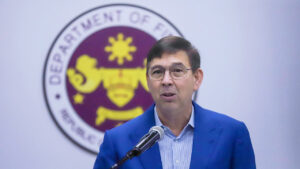THE BANGKO SENTRAL ng Pilipinas (BSP) is expected to continue cutting rates in the next few months, Finance Secretary and Monetary Board Member Ralph G. Recto said Thursday.
“We have cut our interest rates by a total of 50 basis points (bps), creating an even more conducive environment for growth and investment. And more rate cuts are expected in the coming months,” Mr. Recto said in a speech.
The Monetary Board began its easing cycle in August, bringing the central bank’s key rate to 6%.
BSP Governor Eli M. Remolona, Jr. has signaled a possible 25-bp rate cut in December, which would bring the benchmark rate to 5.75% by the end of 2024.
Mr. Recto told reporters on the sidelines of a conference that the BSP will review its easing cycle outlook following the slowdown in third-quarter gross domestic product (GDP) growth, but he noted “there’s a possibility” for a rate cut in December.
The economy expanded 5.2% in the third quarter, the weakest reading since the 4.3% posted in the second quarter of 2023.
Third-quarter growth marked a slowdown from the revised 6.4% posted in the second quarter, and the year-earlier 6%.
The median forecast had been 5.7% in a BusinessWorld poll of 12 economists and analysts ahead of the data release.
On a quarter-on-quarter basis, GDP expanded by 1.7%.
Mr. Recto said rate cuts could put the economy on a strong growth track until 2030 and possibly bringing the Philippines to upper middle-income status by next year.
“The Philippine economy has already doubled in size since 2013 in terms of nominal GDP. And by 2030, our projections show that we can grow by another twofold, and this has not gone unnoticed by the rest of the world,” he said in his speech.
Economic growth will also be supported by strong job numbers and slowing inflation, which will support consumer spending.
“Today, about 50 million Filipinos are employed, and 63.9% of them hold formal, stable jobs. Unemployment has steadily decreased. This is proof of an expanding middle class ready to drive consumer demand,” he said.
The labor force participation rate increased to 65.7% in September from 64.1% a year earlier. The labor force is estimated to number 51.77 million, up 1.84 million.
“Additionally, our whole-of-government efforts to mitigate food and nonfood inflation are expected to keep the inflation rate within our target band for the next two years. Low and stable prices will speed up the growth of our already robust domestic demand, with household consumption accounting for more than 70% of our economy,” Mr. Recto added.
Headline inflation picked up to 2.3% in October from 1.9% in September, but remained below the 4.9% from a year earlier. It was also within the central bank’s 2-4% target.
“With these favorable forces at play, we are on course to reach upper middle income status next year. And by 2030, the Philippines will become the 30th largest consumer market globally,” Mr. Recto said.
The Philippines was classified as a lower middle-income country with a gross national income per capita of $4,230 in 2023, according to World Bank’s income classification standards. It has been a lower middle-income economy since 1987. — Aaron Michael C. Sy

